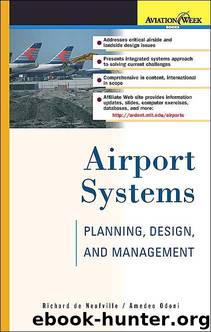Airport Systems: Planning, Design, and Management by Richard de Neufville; Amedeo R. Odoni

Author:Richard de Neufville; Amedeo R. Odoni
Language: eng
Format: mobi
Tags: Airports - Planning, Technology & Engineering, Management, Airports, Reference, Civil, Airports - Management, Commercial, General, Industrial Health & Safety, Planning, Architecture, Aviation, Transportation, Urban & Land Use Planning, Design and Construction, Airports - Design and Construction, Aeronautics & Astronautics
ISBN: 9780071384773
Publisher: McGraw-Hill
Published: 2003-08-15T10:00:00+00:00
12-2 Background and motivation
The principal objective of demand management is to assist in maintaining efficient operations at airports that are threatened by congestion. This is not done through capital investments or changes in traffic handling procedures aimed at increasing capacity, but through regulations or other measures that aim at some combination of (1) reducing overall demand for airfield operations, (2) limiting demand during certain hours of the day, and (3) shifting demand from certain critical time periods to other, less critical ones. The means used to accomplish this objective is what differentiates one demand management approach from another. In all cases, the net effect is to restrain access to airports in some way, either at all times or at selected times. For this reason demand management is also often referred to as access control.
In the absence of a demand management program, access to commercial airports throughout the world is governed by essentially one set of rules. Any aircraft technically qualified to operate at a particular airport, i.e., that fulfills air traffic management and airworthiness requirements, can utilize the airport by paying a landing fee proportional to the weight of the aircraft.* In this environment, any airline may schedule a flight at the airport for any time it wishes, outside any curfew hours that may exist.† A demand management program modifies these conditions. For example, an upper limit may be placed on the number of operations that can be scheduled during a particular period of the day, or a surcharge may be imposed on the landing fee during peak hours.
The motivation for demand management comes directly from a fundamental observation in Chap. 11, namely, that when the utilization of a service facility is high (or when demand approaches the capacity of a system), the relationship between delay, on the one hand, and capacity or demand, on the other, becomes very nonlinear: a small increase in capacity or a small reduction of the demand rate results in a proportionally much larger reduction in delay (with the reverse also being true). Demand management aims at achieving those small reductions in demand (or the shifts in demand from peak to off-peak periods) that will bring about these large delay benefits. In the process, additional benefits may be achieved, such as reduced operating costs through a more efficient utilization of available personnel, equipment, and resources.
It is sometimes argued that demand management of any form is unnecessary, even at the busiest airports, because delay will act by itself as a “natural” access-control mechanism. According to this argument, as delays at an airport grow, more and more prospective aircraft operators will deem the situation unacceptable and will choose not to use the airport. At some point, the costs associated with delay, as perceived by individual users, will become so high that demand will cease to grow and “equilibrium” will be reached.
This line of reasoning misses a critical point. The equilibrium reached in this way will, in general, be inefficient economically, as (1) the associated level of delays
Download
This site does not store any files on its server. We only index and link to content provided by other sites. Please contact the content providers to delete copyright contents if any and email us, we'll remove relevant links or contents immediately.
Whiskies Galore by Ian Buxton(41791)
Introduction to Aircraft Design (Cambridge Aerospace Series) by John P. Fielding(33042)
Small Unmanned Fixed-wing Aircraft Design by Andrew J. Keane Andras Sobester James P. Scanlan & András Sóbester & James P. Scanlan(32727)
Aircraft Design of WWII: A Sketchbook by Lockheed Aircraft Corporation(32187)
Craft Beer for the Homebrewer by Michael Agnew(18121)
Turbulence by E. J. Noyes(7918)
The Complete Stick Figure Physics Tutorials by Allen Sarah(7289)
The Institute by Stephen King(6910)
Kaplan MCAT General Chemistry Review by Kaplan(6849)
The Thirst by Nesbo Jo(6804)
Bad Blood by John Carreyrou(6516)
Modelling of Convective Heat and Mass Transfer in Rotating Flows by Igor V. Shevchuk(6375)
Learning SQL by Alan Beaulieu(6190)
Weapons of Math Destruction by Cathy O'Neil(6116)
Man-made Catastrophes and Risk Information Concealment by Dmitry Chernov & Didier Sornette(5897)
Permanent Record by Edward Snowden(5717)
Digital Minimalism by Cal Newport;(5629)
Life 3.0: Being Human in the Age of Artificial Intelligence by Tegmark Max(5443)
iGen by Jean M. Twenge(5349)
